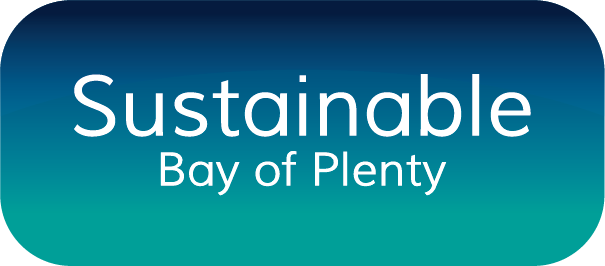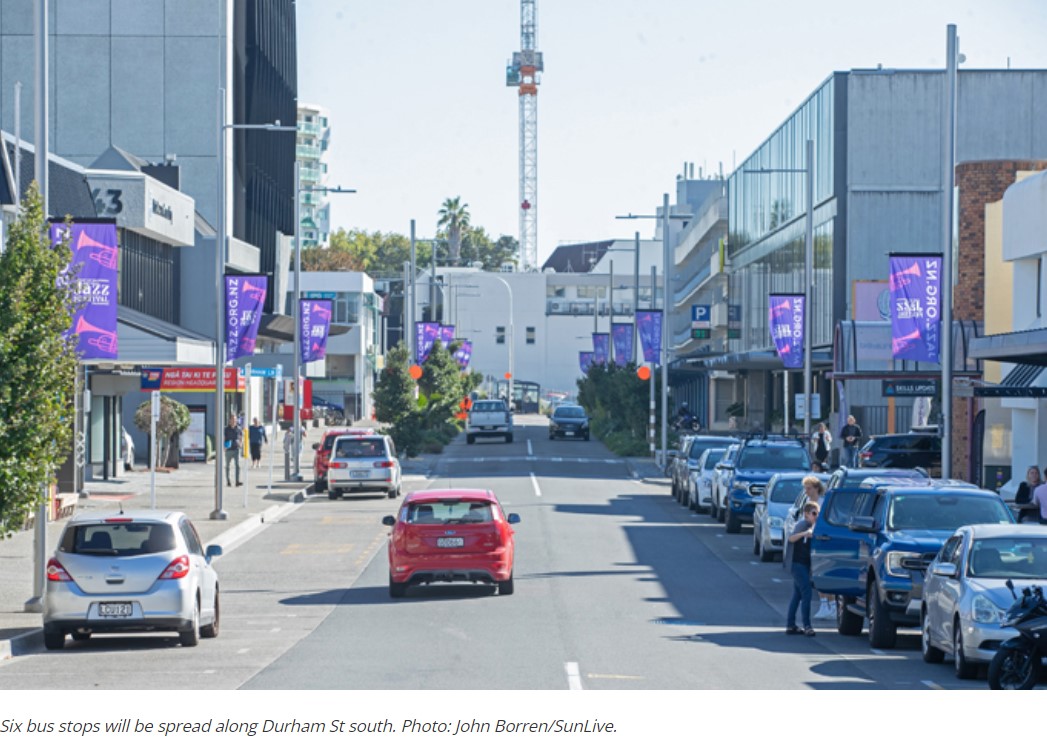by Glen Crowther
This is the latest instalment in our coverage of this issue, which has been ongoing for the past five years or more.
I have been a public transport ‘stakeholder’ for the past decade, I am an advisor to the BOP Regional Transport Committee, and I use buses most days.
In my role with Sustainable BOP Trust, our main office is in Durham St, central Tauranga – the main site of the proposed Tauranga CBD bus hub.
I have a good understanding of this project, including the goals of each council, and I have also been directly involved in the limited (and untimely) stakeholder engagement for this project – which has been fine, but ultimately meaningless.
Some Key Facts
- Virtually all Tauranga-Western BOP public buses travel via the central city
- The CBD hub caters for 80 buses per hour – and more in future
- The selected routes and bus stop locations are not what BOP Regional Council (which runs the buses) or the initial consultant wanted
- The only reason the Regional Council backed Tauranga City Council (TCC) and its proposed ‘interchange’ on Durham St is that TCC pledged to build an accessway or arcade between Durham St and Grey St – which we are now told is not part of TCC’s final proposal
- The options put forward by TCC have all been described as sub-optimal by the experts
- Virtually all stakeholders (including property owners and managers) don’t like any of the options put forward by TCC
- TCC told people (councillors, property owners, public transport advocates) a few years ago that Durham St was NOT a predetermined route or favoured location for a CBD bus hub
- TCC Commissioners now explicitly state that Durham St was always going to be the route and location for the CBD bus stops… is that true? … why the contradictory information?
- The Commissioners’ initial Durham St and Hamilton St options, which stakeholders reluctantly supported as “the best of a bad bunch”, are now not proceeding because property owners and developers didn’t want them
- I have yet to find any property owner that wants bus stops or an interchange outside their building or development site.
The tension around this project is between three groups of people (who overlap):
- CBD Property Owners and Developers
- Bus Users – people traveling to/from the CBD or via the CBD to other locations
- Other People – moving around the CBD via walking, driving, or other modes
So what should TCC do?
Given that NO property owners appear to want a bus stop outside their property, and given that TCC has signed up to UFTI and a Transport System Plan that focus on massively increased bus patronage, we think a solution is needed that:
- Better meets the needs of bus users, and
- Within that constraint, has the minimal adverse impact on property owners and CBD users
We think TCC needs to:
- understand what bus users want
- pay closer attention to stakeholder group feedback and general public feedback
- read bus user surveys and non-bus user surveys
- comprehend the thinking behind the feedback, social media posts, and so forth
Given ALL public buses in Tauranga travel via the CBD, and given that 35% of all people boarding buses in the CBD are transferring between buses, it means TCC needs to provide:
- an interchange (for people to easily change routes) – not just bus stops without easy transfer options
- a well-designed hub that actually attracts more bus users – not one that deters users, as the current location does
This is especially the case because BOP Regional Council data shows:
- 57% of all Accessibility category boardings in the CBD are transfers – latest 2023 data. (Accessibility refers to people with disabilities or other serious mobility issues)
- 62% of all Youth (teenage) boardings in the CBD are transfers – this is a big issue, as many teenagers and their parents are very concerned about safety and accessibility.
In that context, we suggest that Tauranga City Council should put three costed options on the table, before signing off on any proposal. These would offer a genuine choice to the public:
- An off-street Bus Interchange, with option for electric shuttle service around the CBD.
(This has been proposed by disability advocates, elder advocates, sustainability advocates, environmental advocates, property owners and developers, and others.)
There are CBD property owners willing to sell land to the Council for this purpose.- This option frees up parking spaces for cars, not buses.
- It is the most compact solution, and likely the best for bus users and businesses.
- It would likely cost more up front, to buy property and build the interchange, and would have implications for bus logistics (as all options do).
- An on-street Bus Hub on the flat, close to the city centre (Red Square) – either on Willow or Grey St – provides better access for elderly, disabled and other mobility-impaired people.
- Buses don’t need to travel the length of both those streets – just to access that flat central location. e.g. Buses could go down Wharf St. and up Spring St.
- TCC is planning to fully pedestrianise Willow St, so Tauranga could follow many other cities and allow bus access for that one leg – meaning it wouldn’t clog up a street used by cars. By comparison, Durham St is located between the CBD’s two parking buildings!
- It could include toilets and other facilities in Red Square, but would likely be less compact and less ideal for bus users than an interchange (and again, with logistical implications for the bus services).
- An improved Durham St South option = Option 1 from Council’s agenda (item 12.1), but with the following additions:
- Include the previously-discussed Accessway between Durham & Grey Streets (via the property purchased by TCC at 79 Grey St and the alleyway next to Mercury building)
- Provide Toilets – essential, especially with Tauranga’s rapidly aging demographic. (Where? Don’t know.)
- Offer better protection from the weather – Durham St can be windy, and the proposed design will expose people to wind and rain, and it doesn’t solve the heat and glare problem in summer (which is important, as it is uncomfortable for bus users).
- Ensure all bus stops are located close together to enable easier and safer transfers.
- Work in with Durham St property owners’ needs as much as possible.
- Do NOT take out the raingarden by the parking building and require people transferring buses to walk across the parking building entrance – that could be dangerous and impractical for older and disabled bus users. It would also impact traffic from people crossing the road to transfer buses. (Surely it’s a better idea to separate cars from a bus interchange as much as possible?)
- In line with all that, take out the raingarden in front of the Mercury (ex-Trustpower) building, and locate the ‘third’ bus stop in front of Mercury, away from the entrance, at the end nearest the alley.
- Mercury staff told me they no longer provide public access to their building and the building is long enough that a bus stop would not need to be located in front of their entrance doors.
- Relocate the pedestrian crossing on Durham Street to fit with the above design.
Any of those three options would be better than the current proposal, they’d all end up being more successful for increasing bus patronage than TCC’s current plan, they are better future-proofed, and we suggest they’d all be cheaper in the long run.
More importantly, the current proposals don’t get support from anyone outside the Council! Is that the best we can aspire to?
Do we really want a city centre bus hub that no-one seems to like? With the most positive description being “could have been worse”?
We prefer a refreshed approach that responds to feedback and finds a positive solution that caters for the diverse needs of an aging population in our region’s largest and fastest-growing city.
NOTE:
Sunlive features this issue here. You’ll note it confirms the alignment between sustainability advocates, property owners, disability and elder advocates, and others around at least one point: “Collier [a developer] and Crowther both suggested an off-street bus interchange” would be preferable to TCC’s current option.


The busses are too big for our narrow downtown streets, yet the commisioners want wider footpaths and even slower speeds. Impossible to exceed 30kph already
Footpaths are perfectly suitable if they weren’t full of planter boxes and eateries table and chairs.
A toilet block would be much appreciated please.
Tcc is a deaf ear! They don’t want to listen ! Remove all those bloody planters and stuff from the roads, streets are wide enough! They are making the center city more congested which is obviously going to be hard for the buses !
Option No 1 would be the best solution, giving access to the CBD without clogging up the narrow streets.The ability to change from one bus route to another without the need to go into the CBD would also be an improvement.
It’s looking like another just-do-it option. The Commissioners were told to get stuff done and this is another example.
It looks as though a circle bus might be needed rather than a hub. The circle is effectively the hub but users get on and off at their appropriate spoke of the wheel. Circle must be frequent too. If the town centre is not a common destination then something more imaginative is needed. Of course it is a difficult city to do that in. But eliminating a major hub would free up finance for alternatives.
There are 2 issues Ian:
1) Having seen the data, the CBD is by far the most popular destination (and origin for return legs) – because all other trips are split between so many other origins and destinations (including shopping centres and residential areas).
2) TCC has ruled out running buses along The Strand, Devonport Rd, Grey St, and the southern end of Willow St. They might allow a small shuttle to operate a circle route on some of those roads, but they’ve indicated on several occasions they don’t want that.
If it allows such a shuttle, then should BOPRC have to pay, or should TCC? I think TCC, because they’re responsible for bus infrastructure and it’s the lack of suitable infrastructure that means we’d need a shuttle.
The success of suburban shopping centres and the coincident death of the so-called CBD is basically a question of access. Who wants to walk up or down-hill to the bus from The Strand and its side streets, from Devonport Road or Grey Street? The best place for a central bus depot is as close as possible to the destinations of the passengers; especially those laden with their purchases (hopefully), probably elderly and on a wet or stinking hot day. So,the best site is where it used to be, in Willow Street. It is surely not too late for a “hub” to be incorporated into the current (over-ambitious?) re-build of the Civic Centre. That proposal is not sacred!
I tend to agree, along with many other people I know. However I suspect TCC does see their civic centre as somewhat ‘sacred’, in the sense that Willow St was one of the first options that the Commissioners ruled out, along with Brendon Gordon’s idea of a bus interchange built into the civic centre design. TCC’s plan has been to pedestrianize Willow St from Hamilton to Wharf to Spring St, as well as the lower ends of Masonic Park, Wharf St, and Spring St (‘Red square’) and route the buses outside that area, up on Durham St… away from most of the foot traffic.